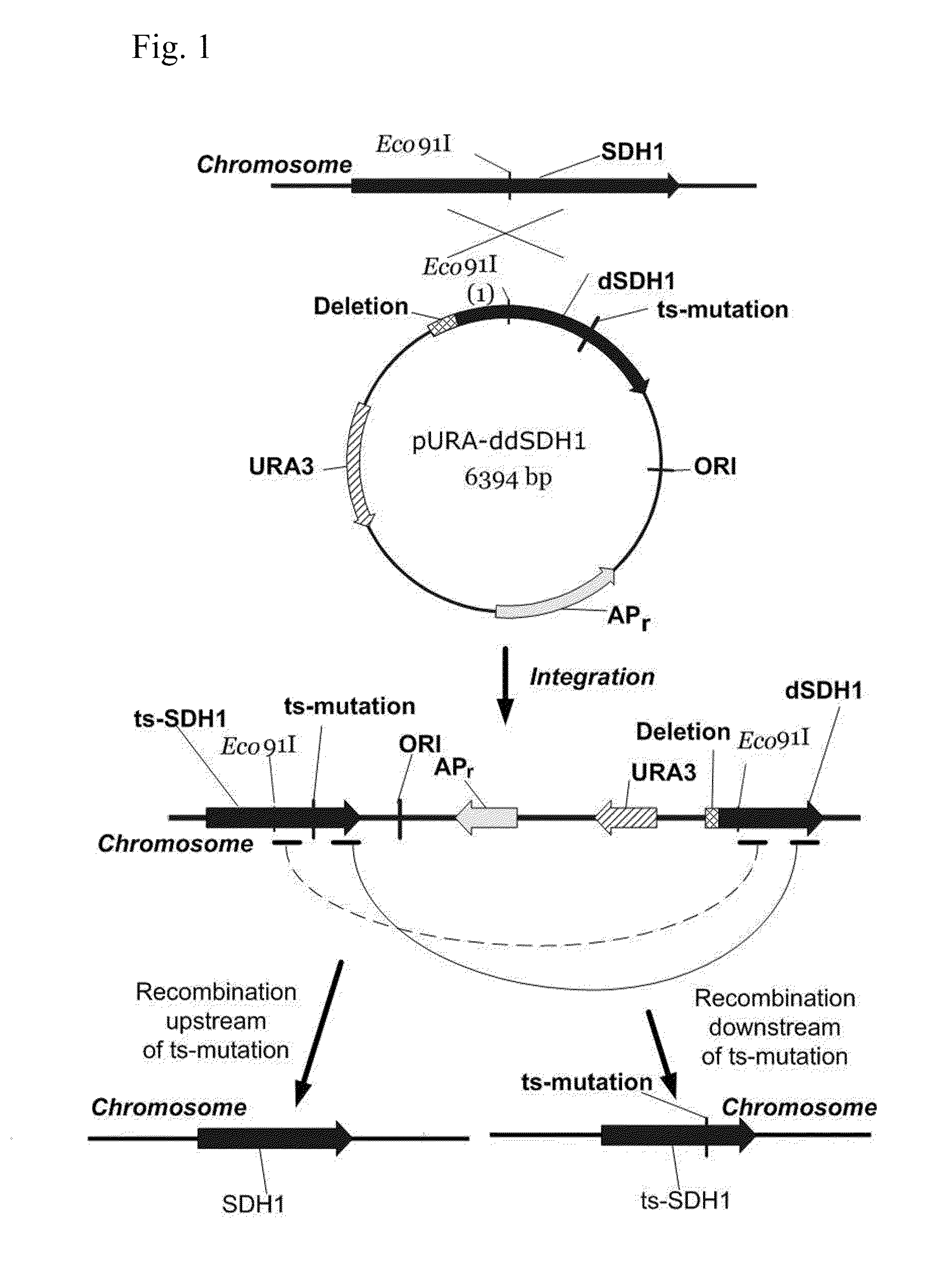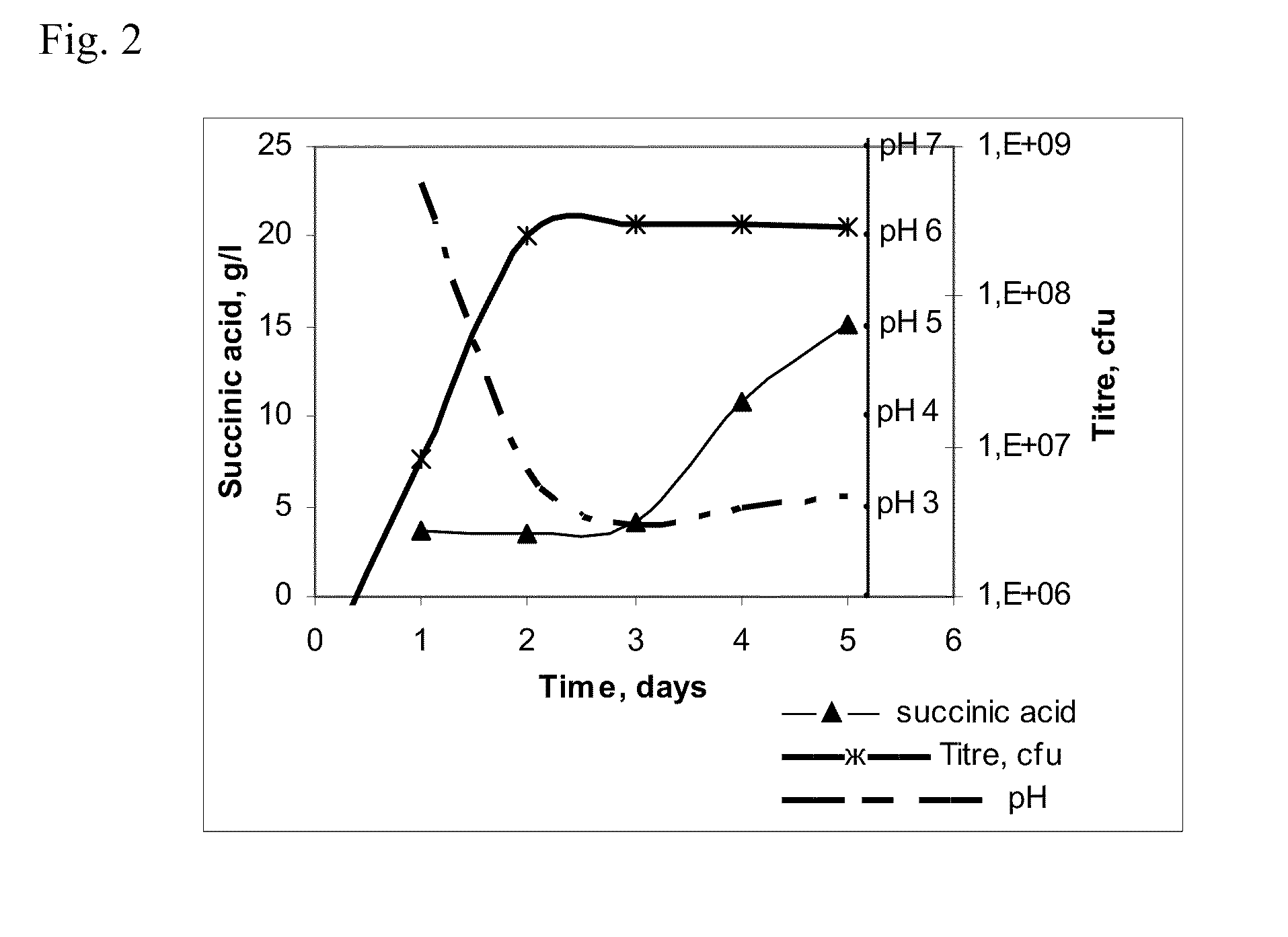METHOD FOR PRODUCING SUCCINIC ACID USING A YEAST BELONGING TO THE GENUS Yarrowia
a technology of yarrowia and succinic acid, which is applied in the field of microorganisms, can solve the problems of no reports of reducing the activity of succinate dehydrogenase, environmental pollution, etc., and achieve the effect of enhancing the productivity of succinic acid
- Summary
- Abstract
- Description
- Claims
- Application Information
AI Technical Summary
Benefits of technology
Problems solved by technology
Method used
Image
Examples
example 1
Construction of a Strain Having a Temperature-Sensitive (ts-) Mutation in the SDH1 Gene
[0061]1. Construction of the Plasmid pURA-ddSDH1
[0062]First, a DNA fragment containing the URA3 gene was obtained using PCR. Primers P1 (SEQ ID NO: 9) and P2 (SEQ ID NO: 10) were used in the PCR. The entire genomic DNA of Y. lipolytica W29 (CLIB (Collection de Levures d'Interet Biotechnologique, 78850 Thiverval Grignon, France (Collection of Yeasts of Biotechnological Interest)) accession number CLIB89) was isolated using the method described by Kaiser et al. (1994 Methods in Yeast Genetics. Cold Spring Harbor, N.Y.: Cold Spring Harbor Laboratory), and was used as the template in the PCR reaction. The Y. lipolytica W29strain can also be obtained from the ATCC (ATCC20460).
[0063]A 1972 by PCR product was obtained and purified in a 1% agarose gel. The PCR product (0.5 μg) was ligated with pUC19 (0.2 μg), which had been previously treated with Ecl136II endonuclease. The obtained plasmid was used for e...
example 2
Construction of a Strain with an Inactivated SDH2 Gene
[0069]First, three DNA fragments containing the promoter region of the SDH2 gene (1125 bp), the URA3 gene (1229 bp), and the terminator region of the SDH2 gene (1018 bp), were obtained by PCR using Pfu polymerase, the entire genomic DNA of Y. lipolytica W29 (ATCC 20460) and primer sets P9 (SEQ ID NO: 17) and P10 (SEQ ID NO: 18), P11 (SEQ ID NO: 19) and P12 (SEQ ID NO: 20), and P13 (SEQ ID NO: 21) and P14 (SEQ ID NO: 22), respectively. The PCR products were purified in a 1% agarose gel. PCR products containing the promoter region of the SDH2 gene (1125 bp) and the URA3 gene (1229 bp) were used as the template in PCR using Pfu polymerase and primers P9 and P12. The PCR product (2333 bp) was purified in a 1% agarose gel. Then, the purified PCR product (2333 bp) and the PCR product containing the terminator region of the SDH2 gene (1018 bp) were used as the template in PCR using Pfu polymerase and primers P9 and P14. The PCR product ...
example 3
Production of Succinic Acid by Y. lipolytica Strains Po1f(SDH1-ts-0134), Po1f(SDH1-ts-2007) and Po1f(dSDH2)
[0070]To test the effect of attenuating the expression of the genes SDH1(YALI0D11374g) or SDH2(YALI0D23397g) on succinate production, the productivity of the strains Po1f(SDH1-ts-0134), Po1f(SDH1-ts-2007), Po1f(dSDH2) and Po1f were compared.
[0071]The strains Po1f(SDH1-ts-0134), Po1f(SDH1-ts-2007), and Po1f (the initial titre of cells was 1-5*105 cell / ml) were each cultivated in 5 ml minimal medium YNB (Himedia) supplemented with glycerol (5% (v / v)), uracyl, and leucine (0.01%), pH=6.8 (adjusted with 50 mM phosphate buffer) in 50 ml test tubes at 24° C. After 2 days of incubation 2.5% CaCO3 was added into the medium to adjust the pH. When the titer of cells reached (0.8-1)*107, some test tubes were transferred so they were cultivated at 32° C., and others were cultivated at 24° C. After 5 days of cultivation, the amount of succinic acid, α-ketoglutaric acid, citric acid, pyruvic...
PUM
| Property | Measurement | Unit |
|---|---|---|
| pH | aaaaa | aaaaa |
| temperature | aaaaa | aaaaa |
| temperature | aaaaa | aaaaa |
Abstract
Description
Claims
Application Information
 Login to View More
Login to View More - R&D
- Intellectual Property
- Life Sciences
- Materials
- Tech Scout
- Unparalleled Data Quality
- Higher Quality Content
- 60% Fewer Hallucinations
Browse by: Latest US Patents, China's latest patents, Technical Efficacy Thesaurus, Application Domain, Technology Topic, Popular Technical Reports.
© 2025 PatSnap. All rights reserved.Legal|Privacy policy|Modern Slavery Act Transparency Statement|Sitemap|About US| Contact US: help@patsnap.com


